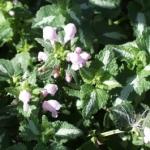| Common Name: |
White Deadnettle |
| Other Names: |
Archangel |
| Botanical Name: |
Lamium album |
| Genus: |
Lamium |
| Family: |
Lamiaceae |
| Native Location: |
Eurasia; naturalized in eastern N America |
| Cultivation: |
Moist, well-drained soil in sun or partial shade. |
| Propagation: |
By seed sown in autumn or spring (species only); by division in autumn or early spring; by stem-tip cuttings of non-flowering shoots in summer. |
| Harvest: |
Whole plants are cut when in flower, or flowers are removed individually; both are dried for use in infusions and tinctures. |
| Height: |
15-60cm (6-24in) |
| :Width |
60-90cm (24-36in) |
| Variations: |
Friday
Has gold centered leaves in two shades of green.
Height: 45-60cm (18-24in)
Width: 45-60cm (18-24in) |
| Hardiness: |
Z3-9 |
| Parts Used: |
Whole plant, flowers. |
| Properties: |
A slightly bitter, astringent, decongestant herb that checks bleeding and reduces inflammation. |
| Medicinal Uses: |
Internally for menstrual problems, bleeding after childbirth, vaginal discharge, and prostatitis. Externally as a douche for vaginal discharge. Combines well with Achillea millefolium (See, yarrow) for vaginal discharge, with Vinca major (See, Greater periwinkle) or Geranium maculatum (See, American cranesbill) for heavy menstruation, and with Elymus repens (See, quack grass), Hydrangea arborescens (See, wild hydrangea) or Zea mays (See, corn) for prostate problems. |
| Culinary Uses: |
Flowers are candied or used to make a pleasant herb tea. Young leaves are edible when cooked as a potherb or added to other dishes, and are mixed with sorrel (Rumex acetosa, See, sorrel) as an ingredient of the French eel dish, anguille au vert à la flamande. |
| Bibliography: |
Encylopedia of Herbs by Deni Brown Copyright ©: 1995, 2001 Dorling Kindersley Limited pp.250-251
|
